COVID19 Timelines – Learn to improve
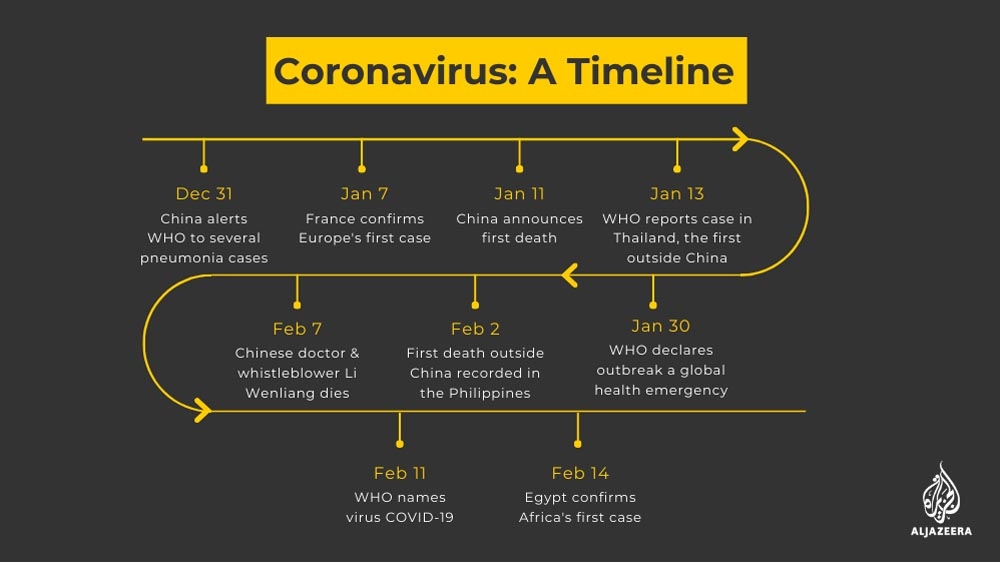
This world timeline comes from this article at AlJazeera. We are making an specific timelime for Spain
https://www.aljazeera.com/news/2020/01/timeline-china-coronavirus-spread-200126061554884.html
Timeline: How the new coronavirus spread
The World Health Organization (WHO) has declared a pandemic over a new coronavirus which causes an illness known as COVID-19 that has spread to at least 170 countries and territories.
The disease has killed more than 31,000 people and infected some 678,000 according to data compiled by Johns Hopkins University.
On December 31 last year, China alerted WHO to several cases of unusual pneumonia in Wuhan, a port city of 11 million people in the central Hubei province. The virus was unknown.
Several of those infected worked at the city’s Huanan Seafood Wholesale Market, which was shut down on January 1.
As health experts worked to identify the virus amid growing alarm, the number of infections exceeded 40.
On January 5, Chinese officials ruled out the possibility that this was a recurrence of the severe acute respiratory syndrome (SARS) virus – an illness that originated in China and killed more than 770 people worldwide in 2002-2003.
On January 7, officials announced they had identified a new virus, according to the WHO. The novel virus was named 2019-nCoV and was identified as belonging to the coronavirus family, which includes SARS and the common cold.
Coronaviruses are common and spread through being in proximity to an infected person and inhaling droplets generated when they cough or sneeze, or touching a surface where these droplets land and then touching one’s face or nose.
On January 11, China announced its first death from the virus, a 61-year-old man who had purchased goods from the seafood market. Treatment did not improve his symptoms after he was admitted to hospital and he died of heart failure on the evening of January 9.
On January 13, the WHO reported a case in Thailand, the first outside of China, in a woman who had arrived from Wuhan.
On January 16, Japan’s health ministry reported a confirmed case in a man who had also visited Wuhan.
On January 17, as a second death was reported in Wuhan, health authorities in the US announced that three airports would start screening passengers arriving from the city.
Authorities in the United States, Nepal, France, Australia, Malaysia, Singapore, South Korea, Vietnam and Taiwan confirmed cases over the following days.
On January 20, China reported a third death and more than 200 infections, with cases also reported outside Hubei province including in the capital Beijing, Shanghai and Shenzhen.
Meanwhile, a Chinese expert on infectious diseases confirmed human-to-human transmission to state broadcaster CCTV, raising fears of a major outbreak as millions travelled for the Lunar New Year holiday.
Asian countries ramped up measures to block the spread of the virus, introducing mandatory screenings at airports of all arrivals from high-risk areas of China.
On January 22, the death toll in China jumped to 17 with more than 550 infections. Many European airports stepped up checks on flights from Wuhan.
Wuhan was placed under effective quarantine on January 23 as air and rail departures were suspended.
The same measures were announced for two more cities in Hubei province: Xiantao and Chibi.
Beijing cancelled events for the Lunar New Year, starting on January 25, while officials reported the first death outside Hubei.
The WHO said later on January 23 that the outbreak did not yet constitute a public emergency of international concern and there was “no evidence” of the virus spreading between humans outside of China.
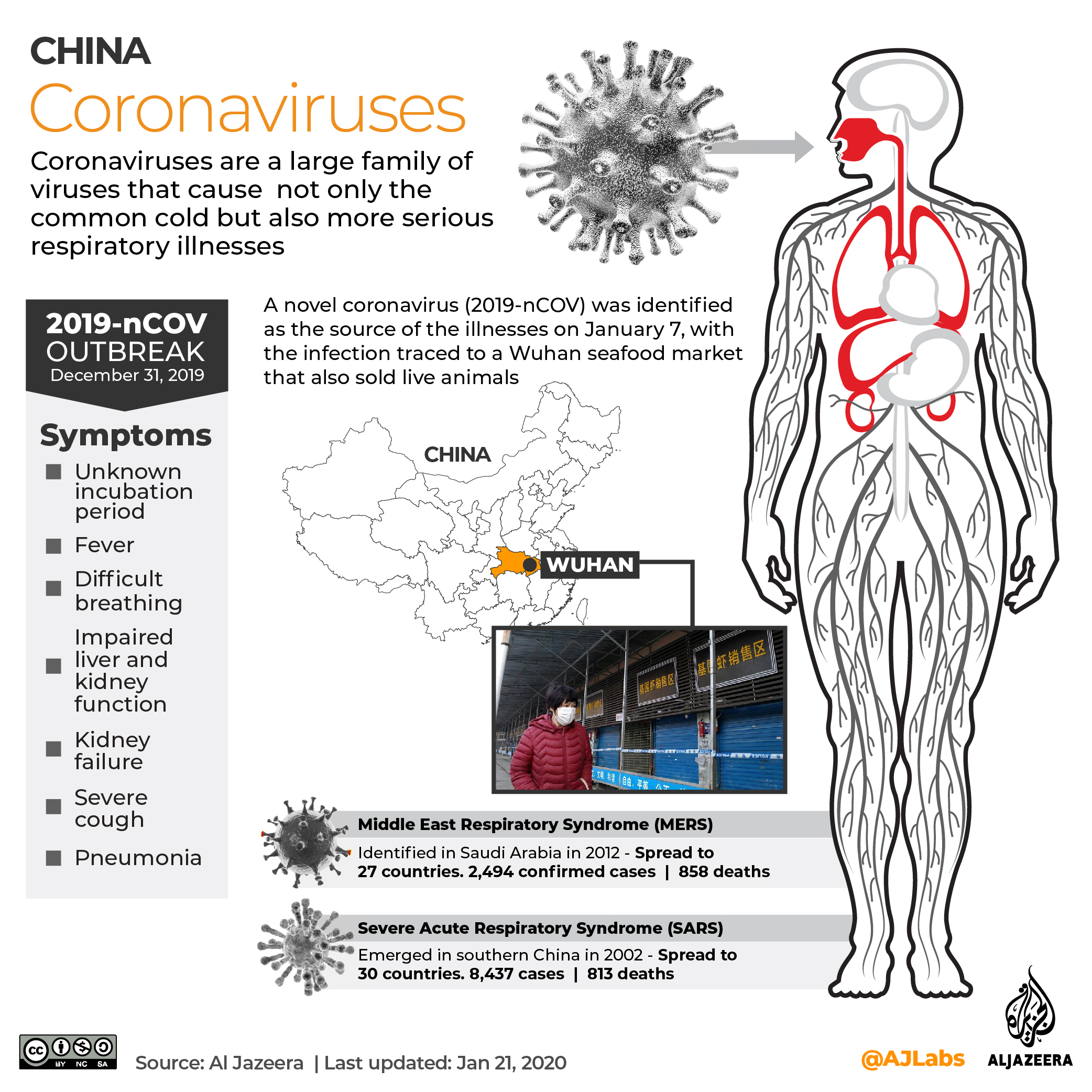
By January 24, the death toll in China stood at 26, with the government reporting more than 830 infections.
The number of cities under lockdown in Hubei rose to 13, affecting 41 million people.
Shanghai Disneyland shut down and other cities announced the closure of entertainment venues. Beijing said a section of the Great Wall and other famous landmarks would also be closed.
On January 25, travel restrictions were imposed on a further five cities in Hubei, taking the overall number of people affected to 56 million.
Hong Kong meanwhile declared a virus emergency, cancelled Lunar New Year celebrations and restricted links to mainland China.
On January 26, the death toll rose to 56, with almost 2,000 cases confirmed as travel restrictions were increased and Hong Kong closed its Disneyland and Ocean Park theme parks.
New cases were confirmed in the US, Taiwan, Thailand, Japan and South Korea.
As of January 27, the death toll in China rose to 106, with 100 in Hubei province, authorities reported. Another 4,515 people in China were reported to be infected. There were 2,714 confirmed cases in Hubei province, up from 1,423 the day before.
On January 30, the WHO declared coronavirus a global emergency as the death toll in China jumped to 170, with 7,711 cases reported in the country, where the virus had spread to all 31 provinces.
India and the Philippines confirmed their first cases of the virus, with one infected patient in each country.

On January 31, the number of confirmed cases in China jumped to 9,809. Russia, Spain, Sweden and the United Kingdom confirmed their first cases of the virus.
On February 1, the death toll in China rose to 259, with 11,791 confirmed infections in the country, according to new figures released by the Chinese health authorities.
New cases were confirmed in Australia, Canada, Germany, Japan, Singapore, the US, the UAE and Vietnam.
As of February 2, the first death outside China, of a Chinese man from Wuhan, was reported in the Philippines.
The death toll in China rose to 304, with 14,380 infections reported.
On February 3, China reported 57 new deaths, bringing its death toll to at least 361. The number of cases rose to 17,205 across the country.
On February 4, China said the death toll rose to 425 people and the number of infected people stood at 20,438 in the mainland. Hong Kong also reported one death, bringing global deaths to 427. The first case was confirmed in Belgium in a person who was repatriated from Wuhan.
On February 5, more flights evacuating US citizens returned from Wuhan and the WHO reaffirmed there was “no known effective treatment” for the coronavirus.
Meanwhile, China reported 490 deaths and 24,324 cases of infection.
On February 6, the death toll in mainland China rose to at least 563, with more than 28,000 cases confirmed.
Meanwhile, authorities in Malaysia reported the country’s first known human-to-human transmission and the number of people infected in Europe reached 30.
On February 7, Li Wenliang, a doctor who was among the first to sound the alarm over the coronavirus, died, and Hong Kong introduced prison sentences for anyone breaching quarantine rules.
Mainland China confirmed the death toll had reached at least 636, with 31,161 cases of infection and Chinese researchers suggested the pangolin may have been one link in the chain of animal-human infections.
On February 8, a US citizen died in Wuhan.
A Japanese man in his 60s with a suspected coronavirus infection also died in hospital in Wuhan, Japan’s foreign ministry said.
The death toll in China reached 722, with 34,546 confirmed infections.
| China under pressure as coronavirus death toll exceeds SARS (3:22) |
On February 9, the death toll in China surpassed that of the 2002-03 SARS epidemic, with 811 deaths recorded and 37,198 infections.
An investigative team led by experts from the WHO departed for China.
As of February 10, China had 908 confirmed deaths and a total of 40,171 infections – 97 new deaths were reported following the deadliest day of the outbreak.
President Xi Jinping appeared in public for the first time since the epidemic began, visiting a hospital in Beijing and urging confidence in the battle against the virus.
On February 11, the WHO announced that the new coronavirus would be called “COVID-19”.
Meanwhile, deaths in China reached 1,016, with 42,638 infections recorded.

As of February 12, there were 175 people infected on board the Diamond Princess cruise ship, docked at Yokohama, the Japanese health ministry said.
The death toll in mainland China hit 1,113, with 44,653 infections recorded.
On February 13, North Korea imposed a month-long quarantine on all foreign visitors and others suspected to have COVID-19, the official Korean Central News Agency said.
The death toll in mainland China hit 1,300, with nearly 60,000 infections recorded. Meanwhile, Japan confirmed its first death from the virus.
| THE LISTENING POST: Speaking up about the coronavirus – but at what cost? (24:39) |
On February 14, Egypt became the first country in Africa to report a case and France reported Europe’s first death from the virus.
China reported 121 more deaths, bringing to the total number across the mainland to nearly 1,400.
February 15 saw the death toll in mainland China surge past 1,500, with 66,492 infections confirmed in mainland China.
Elsewhere, the US prepared to evacuate its citizens from a cruise ship quarantined at a Japanese dock.
Meanwhile, a February 3 speech by Chinese President Xi Jinping, published by state media, indicated the government knew about the threat of the virus well before the public alarm was raised.

On February 16, Taiwan recorded its first death of a taxi driver in his 60s due to the coronavirus.
Authorities reported that 1,665 people had died in mainland China with 68,500 cases of infection reported.
As of February 17, there were 1,770 deaths reported in mainland China and 70,548 cases.
Japan confirmed 99 new cases of the virus on board the quarantined Diamond Princess cruise ship.
February 18 saw China’s daily infection figures drop below 2,000 for the first time since January, with the country’s health commission reporting 72,436 infections on the mainland and 1,868 deaths.
Meanwhile, Russia said it would ban entry for Chinese citizens from February 20.
| Coronavirus outbreak: Ethiopia steps up prevention measures (2:50) |
On February 19, Iran reported two deaths from the coronavirus, hours after confirming its first cases.
China’s daily infection figures drop below 2,000 for the second straight day, with the country’s health commission reporting 74,185 infections on the mainland and 2,004 deaths.
On February 20, South Korea reported its first death from the coronavirus.
Meanwhile, China reported the death toll had risen to 2,118 while the total number of cases reached 74,576. The country’s health commission reported daily infections dropped to the lowest in almost a month, a result of authorities only counting cases confirmed by genetic testing in Hubei.
On February 21, South Korea reported its second death and 100 new confirmed cases of the coronavirus, bringing the total to 204. In mainland China, the death toll reached 2,236 as the confirmed cases of the infection rose above 75,400.
Also, Israel reported its first confirmed case of the coronavirus after a woman who returned from a cruise ship tested positive.
In Italy, the region of Lombardy reported the first local transmission of the virus with three new cases bringing the total in the country to six infections.
On February 22, South Korea saw its largest spike in a single day with 229 new cases of the virus.
Italy reported its first two deaths, while Iran confirmed a fifth death among 10 new infections. A sixth death was later confirmed, though it was not clear whether this case was included in the country’s 28 confirmed cases.
In mainland China, the number of new infections fell significantly with 397 cases reported.
February 23 saw several countries close their borders with Iran as the number of infections and deaths in the country grew.
In Italy, officials confirmed a third death, while local authorities brought the Venice Carnival to an early close and suspended sports events in an attempt to combat the spread of the virus in Europe’s worst-hit country.
On February 24, Kuwait, Bahrain, Iraq, Afghanistan and Oman all reported their first cases of the virus. Meanwhile, the number of cases in South Korea ballooned to 833 cases with seven deaths.
The death toll in China rose to 2,595 among 77,262 confirmed cases.
A seventh death was reported in northern Italy.
On February 25, Iran’s deputy health minister, who had a day earlier given a press briefing on the outbreak, confirmed that he had coronavirus. The country’s official total reached 95 cases with 15 deaths.
Meanwhile, China’s reported cases continued to plateau, with 518 new infections and 71 new deaths confirmed. South Korea’s confirmed cases rose to 977 while Italy’s reached 229.
On February 26, the global death toll neared 2,800 with a total of about 80,000 confirmed infection cases reported globally.
Norway, Romania, Greece, Georgia, Pakistan, North Macedonia and Brazil all detected their first cases of the coronavirus.
On February 27, Estonia, Denmark, Northen Ireland and the Netherlands reported their first coronavirus cases. The number of infections passed 82,000 worldwide, including more than 2,800 deaths.
Italy has seen a spike in infections which jumped to 650, while 3 more people died with the tally of deaths now at 17.
Meanwhile in the US, the administration is considering invoking the Defense Production Act which would grant President Donald Trump the power to expand industrial production of key materials or products for national security.
On February 28, Lithuania and Wales reported their first coronavirus cases, with Netherlands and Georgia reporting their second
| Coronavirus: Stories of quarantine |
February 29 saw South Korea report its highest daily number of confirmed cases yet, 813, bringing the country’s total to 3,150 with 17 deaths. Iran also reported the number of its cases had jumped 388 cases to 593 in 24 hours, with the death toll reaching 43.
Meanwhile, Qatar confirmed the first case in the country.
On March 2, Saudi Arabia’s health ministry announced its first coronavirus case. The victim travelled from Iran to the Gulf kingdom through Bahrain, the state-run Saudi Press Agency reported.
Tunisia and Jordan also reported their first cases as the outbreak continues to spread in the Middle East.
On March 3, Italy announced the death toll in the country reached 77, equalling the total deaths in Iran, which stand at 77.
On March 7, the coronavirus had killed nearly 3,500 people and infected another 102,000 people across more than 90 countries.
China’s Health Commission reported 99 new cases, down from 143 cases the day before, with a total of 80,651 cases nationwide. Official data, meanwhile, showed China’s exports plunging 17.2 percent in the first two months of the year after the outbreak brought much of the country to a halt.
In Iran, one of the worst-hit countries with 4,747 reported cases and 124 deaths, recently-elected MP Fatemeh Rahbar died from the coronavirus.
On March 8, Saudi authorities locked down the eastern Qatif region in a bid to contain the fast-spreading virus. Riyadh also said it was suspending all schools and universities across the country from Monday until further notice.
In Italy, the government imposed a strict quarantine in the state of Lombardy and 14 other areas in the north, affecting a total of 16 million people.
On March 9, Iran released about 70,000 prisoners because of the coronavirus outbreak in the country, Iranian judiciary chief Ebrahim Raisi said, without specifying if or when those released would need to return to jail.
Germany reported its first two deaths, with at least 1,100 confirmed cases in the country.
On March 10, Both Iran and Italy recorded their highest death tolls in a single day. A total of 54 people died in Iran over a 24-hour period, while in Italy, 168 new fatalities were recorded from the coronavirus.
Lebanon and Morocco reported their first deaths from the virus, while Democratic Republic of the Congo, Panama and Mongolia confirmed their first cases of infection.
On March 11, WHO declared the coronavirus outbreak a pandemic, as Turkey, Ivory Coast, Honduras and Bolivia confirmed their first cases.
In Qatar, infections jumped drastically from 24 to 262 in a single day.
On March 12, the global death toll surpassed 4,600 with infections exceeding 126,100 cases. China reported 15 new cases, its lowest number since the daily reporting on infections began seven weeks ago.
On March 15, Spain reported about 2,000 new coronavirus cases and more than 100 deaths over the last 24 hours. The new figures raise Spain’s COVID-19 death toll to 288, with more than 7,700 people infected.
Kazakhstan, the Phillipines and Austria announced tightened restrictions in a bid to contain the coronavirus outbreak.
On March 16, New York Mayor Bill de Blasio ordered the city’s bars, theatres and cinemas to close down, as the number of cases continued to rise in the US.
On the same day, more cases were reported in Turkey and Pakistan, while Iran registered a total of 14,991 infections and 853 deaths.
The Gulf region marked its first death due to coronavirus in Bahrain.
In Africa, Somalia confirmed its first case of the new coronavirus.
Two South American countries, Chile and Guatemala, announced they had closed their borders as part of measures aimed at containing the virus.
On March 17, Italy reported 345 new coronavirus deaths in the country over the past 24 hours taking its total death toll to 2,503 – an increase of 16 percent. The total number of cases in Italy rose to 31,506 from a previous 27,980, up 12.6 percent – the slowest rate of increase since the contagion came to light on February 21.
Turkey, meanwhile, reported its first death related to the pandemic, an 89-year-old person.
On March 18, Australian Prime Minister Scott Morrison declared for the first time ever a “human biosecurity emergency” in the country.
Morrison said the travel advisory had been upgraded to the highest level and told Australians: “Do not travel abroad, do not go overseas.”
Italy, meanwhile, recorded 475 new deaths, the highest one-day toll of any nation, taking its total to 2,978. The total number of infections in the country reached 35,713.
For the first time since the start of the epidemic, no new domestic cases were reported in China.
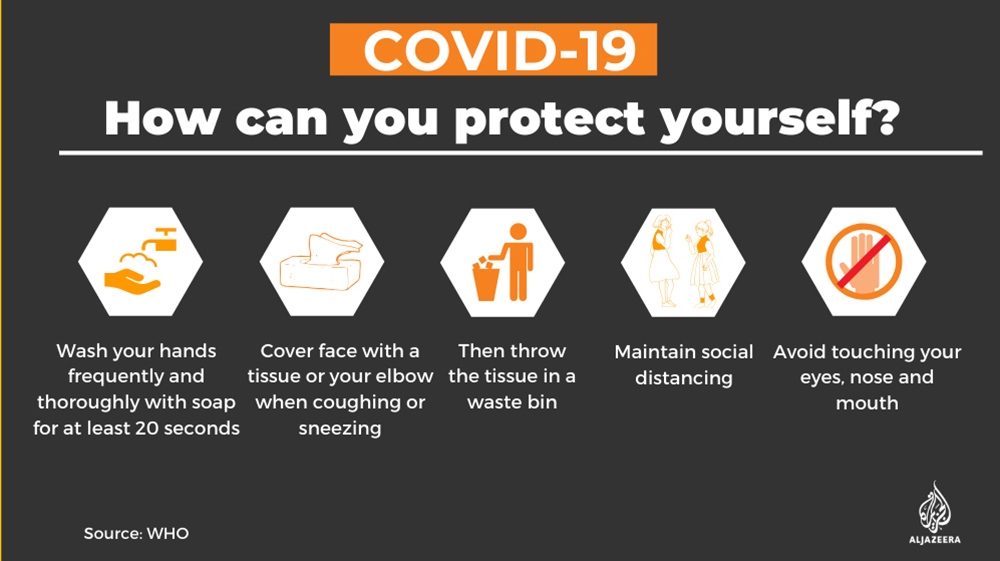
On March 19, Italy overtook China as the country with the most coronavirus-related deaths, registering 3,405 dead compared to 3,245 in China.
The death toll in Spain soared by 209 to 767 fatalities from the previous day. A roughly 25 percent increase in infections was recorded, taking the country’s total to 17,147.
On March 20, coronavirus-related deaths surged past 10,000 globally. The number of cases in Germany rose by 2,958 overnight to 13,957. Spain, meanwhile, said the death toll due to COVID-19 had risen to 1,002.
In China, however, no new domestic cases were reported for a second consecutive day even as concerns remained about infected people flying into the country and importing a second wave of the disease.
On March 21, Europe remains the epicentre of the coronavirus with Italy reporting 793 new fatalities, its biggest daily increase, bringing the total number of deaths to 4,825 amid 53,578 cases.
Spain is the second worst-hit country in Europe with more than 21,000 infections and at least 1,000 deaths.
To help each European country to contain the pandemic, the EU has taken the unprecedented step to suspend rules on public deficits, giving countries free rein to inject spending into the economy as needed.
Meanwhile, the first two fatalities have been reported in Singapore.
On March 22, the global death toll rose above 13,000 while the infection count surpassed 311,000. Governments around the world continued to lock down their countries, with the latest curfew coming into effect in India. The besieged Palestinian territory of Gaza registered its first two coronavirus cases.
On March 23, Italy reported 602 new deaths, bringing
the total to 6,077 with the tally of cases in the country rising
to 63,928. Meanwhile, in the US, the number of cases surged past 35,000,
with a death toll of 495, according to John Hopkins University data.
On March 24, Spain
reported 6,600 new coronavirus cases, bringing the total number of
infections to 39,673, while fatalities rose to 2,696 from 2,182 the
previous day.
Laos recorded its first two coronavirus cases.
On March 25, the White House and Senate leaders of both parties struck an agreement on a sweeping $2 trillion measure to aid workers, businesses and a healthcare system strained by the rapidly spreading coronavirus outbreak.
Meanwhile, India’s 1.3 billion people joined the global lockdown, and Spain recorded more than 700 deaths over the previous 24 hours, surpassing China in the total death toll, making the country now second to only Italy.
On March 26, the total number of coronavirus cases globally surpassed 500,000.
Cases in Europe topped 250,000 – more than half of which were in Spain and hard-hit Italy. Spain recorded 655 new fatalities over 24 hours, while Italy’s death toll rose by 712 to hit 8,215.
Kenya, Kazakhstan and Honduras all reported their first deaths.
On March 27, UK Prime Minister Boris Johnson announced he had tested positive for the coronavirus.
“Over the last 24 hours I have developed mild symptoms and tested positive for coronavirus,” Johnson said in a video posted on Twitter. “I am now self-isolating, but I will continue to lead the government’s response via video-conference as we fight this virus.”
In Spain, meanwhile, the death toll rose to 4,858 after 769 people died over 24 hours, while South Africa recorded its first two deaths as a three-week nationwide lockdown came into force.
On March 28, the number of cases worldwide surpassed 600,000, with more than 27,000 deaths.
Spain’s death toll meanwhile jumped to 5,690, with 832 fatalities in the past 24 hours, according to the country’s health ministry. In the US, the number of people infected with the virus hit more than 104,000, while fatalities exceeded 1,700.
Italy’s death toll from the virus also shot past 10,000 with 889 new deaths, according to the country’s civil protection service.
On March 29, the US accounted for the highest number of coronavirus infections in the world, recording more than 124,000 cases. The death toll in the country surged past 2,000, more than double the figure two days ago.
Spain’s health ministry announced 838 new coronavirus deaths, marking the country’s highest daily jump in fatalities and bringing its total to 6,528.
Trump extends social distancing rules until April 30 as New York state surpassed a grim milestone in its death toll. by Zaheena Rasheed & Umut Uras30 Mar 2020 07:35 GMT
US President Donald Trump has extended federal guidelines on social distancing until April 30 after a top health official warned more than 100,000 people could die from the coronavirus in the United States.
The announcement on Sunday evening came as the death toll in hard-hit New York state passed 1,000.
“The modeling estimates that the peak in death rate is likely to hit in two weeks,” Trump told reporters at the White House. “Therefore, the next two weeks and during this period it’s very important that everyone strongly follow the guidelines … We will be extending our guidelines to April 30th to slow the spread.”
More:
- Coronavirus: Which countries have confirmed cases?
- Why is Italy’s coronavirus fatality rate so high?
- Timeline: How the new coronavirus spread
The initial 15-day period had been due to expire on Monday.
The US has 139,000 confirmed infections from the coronavirus, more than any other country in the world, while more than 2,400 people have died from the respiratory illness caused by the pathogen.
Worldwide, the number of cases has reached more than 718,000. Some 149,000 people have recovered, and more than 33,000 have died.
Here are all the latest updates:
Monday, March 30
07:34 GMT – Serbia to invest 5 billion euros to cope with coronavirus impact
Serbia plans to offer about five billion euros ($5.54bn) in loans and subsidies to businesses to help them cope with the economic impact of the coronavirus.
President Aleksandra Vucic said that the state will also make a one-off payment of 100 euros to every Serbian citizen older than 18, or around five million people.
So far, 13 people in Serbia, out of a population of seven million, have died from the coronavirus and more than 700 have been infected.
To counter the outbreak, Serbia introduced stringent measures, including a state of emergency and an overnight lockdown for all.
07:14 GMT – People around the world pay tribute to healthcare workers
People around the world are paying their tributes to frontline healthcare staff battling the worsening coronavirus pandemic.
As lockdowns become increasingly common around the globe, citizens living largely indoors have expressed their gratitude in various ways to nurses, doctors and other health workers, who are on the frontline of the struggle.
Tributes to the healthcare workers at the frontlines of the coronavirus pandemic are pouring in worldwide 🧡 pic.twitter.com/K1VJsptbQp — Al Jazeera English (@AJEnglish) March 30, 2020
06:50 GMT – Lockdown in India hits HIV+ patients hard
India’s ongoing strict COVID-19 lockdown has widely affected HIV-positive and chronic patients with critical conditions.
They face problems in accessing health services amid strict restrictions across the country, which is believed to be home to the third-largest population of HIV-positive people in the world.
There are 21.4 million Indians living with HIV, according to the National Aids Control Organisation data in 2017.
Read more here.
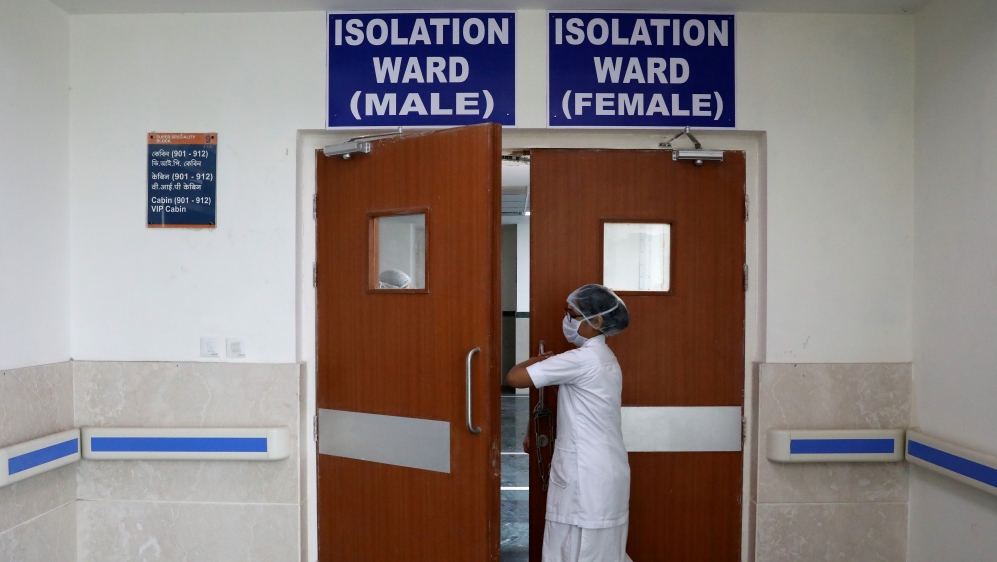
The lockdown seems to be taking a toll on the HIV-positive people along with other patients [Rupak De Chowdhuri/Reuters]
06:40 GMT – Thailand reports two new coronavirus deaths
Thailand’s public health ministry said that two more people have died from the new coronavirus, bringing the total number of deaths in the country to nine.
The two deaths included a 54-year-old Thai man in the southern province of Yala who had recently returned from Malaysia, and a 56-year-old Thai woman in Bangkok, said Anupong Sujariyakul, a senior official at the public health ministry’s Department of Disease Control. The two died on Sunday, he added.
Earlier on Monday, Thailand reported 136 new coronavirus cases, raising the total number of infections to 1,524.
06:30 GMT – EasyJet grounds fleet, furloughs cabin crew for two months
British low cost airline easyJet said it had grounded its entire fleet and reached a deal with its cabin crew for employees to be furloughed for two months under a government job retention scheme.
The airline said that its entire fleet of over 300 aircraft was parked up and there was no certainty for the date of restarting commercial flights.
EasyJet said that under a deal with Unite, the union which represents its cabin crew, they would not work for two months from April 1 and will be paid 80 percent of their average pay under the government job retention scheme.

The airline said that there was no certainty for the date of restarting commercial flights.[File: Regis Duvignau/Reuters]
06:00 GMT – Guatemalan deported from US tests positive
A Guatemalan man who was deported from the US last week has tested positive for the novel coronavirus, according to a spokeswoman for the Guatemalan health ministry.
The 29-year-old man was deported last Thursday on a flight chartered by the US Immigration and Customs Enforcement (ICE) agency. The flight, with at least 40 others on board, originated in Mesa, Arizona, according to the Guatemalan Migration Institute.
Read more on this story here.
A curfew to combat the spread of the virus in Guatemala has been extended until April 12.
05:50 GMT – Nepal extends lockdown until April 7
The government of Nepal extended a nationwide lockdown put in place on March 23 by another week. International flights will also be banned until April 15.
The Himalayan country has recorded a total of five infections from the new coronavirus.
05:35 GMT – Japan to ‘ban all travellers from US, China, Europe’
All visitors from the United States, China, South Korea and most of Europe will be denied entry to Japan under new rules to curb coronavirus infections, according to the Asahi newspaper.
Citing government sources, Asahi said Japan’s foreign ministry is expected to also advise Japanese nationals to refrain from travelling to those countries.
| Qatar Airways launches campaign to take stranded travellers home (6:15) |
04:51 GMT – Australia tightens curbs on public gatherings
New rules limiting public gatherings to just two people in Australia will come into effect at midnight on Monday, with the states of New South Wales and Victoria introducing hefty fines for people violating those restrictions.
Prime Minister Scott Morrison said members of the public should leave their house only to buy food, attend medical appointments and for exercise.
Skate parks, outdoor gyms and public playgrounds across the country, he said.
04:20 GMT – Fears of a second wave of infections in China
Concern of a second wave of infections is growing in China amid official pressure to resume normal life, according to Al Jazeera’s Katrina Yu.
“In Wuhan, the epicentre of China’s coronavirus outbreak, some shops are open, and malls are starting to open their doors after two months. People who work in essential industries, such as the cement, steel and car industries, are also starting to go back to work,” Yu said from Beijing.
Our correspondent said officials are under “tremendous pressure to resume normal life” with President Xi Jinping travelling on Sunday to a port and an industrial park in eastern Zhejiang Province to inspect the resumption of work and production there.
“He wants to get the economy going after two months at a standstill. And because of this urgency to get things going, there are fears it may be too soon and could result in a second wave of infections,” she said. “Officials are also under pressure to keep numbers down, and that’s causing fears they may not be transparent when it comes to reporting new cases.”
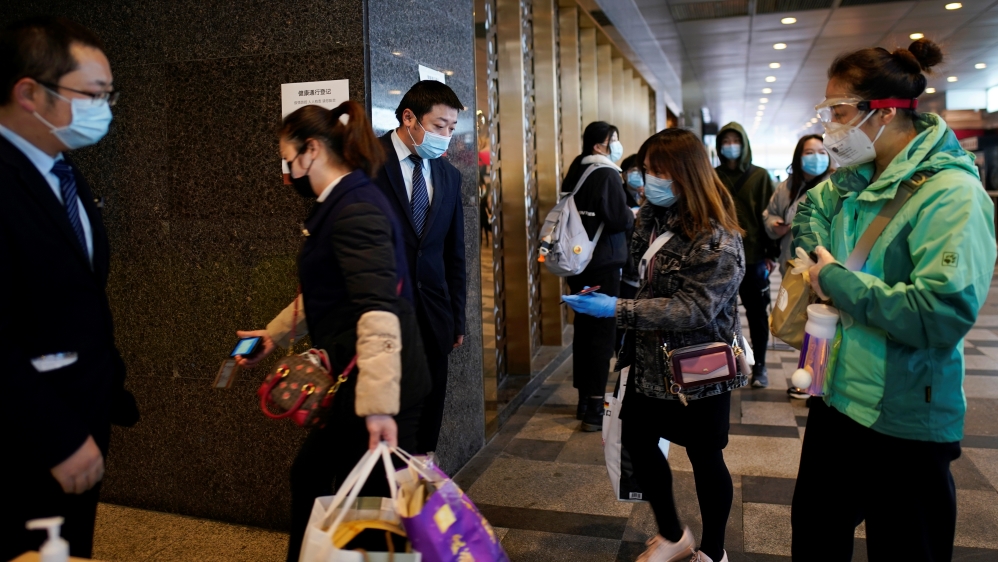
Management staff check QR codes on the mobile phones of people entering a shopping mall at its entrance in Wuhan, Hubei province, on March 30, 2020 [Aly Song/ Reuters]
03:15 GMT – Lockdown leaves migrant workers stranded in Thailand
When Thailand’s government started shutting down the country’s capital, Bangkok last week, tens of thousands of migrant labourers who were suddenly out of work, scrambled to return home to Myanmar.
But for Ma Moe Moe returning home is not an option. The 44-year-labourer was fired from her job at a silk garment factory recently, but she is hunkering down with her husband in Bangkok, saying she feared she might not be able to return to Thailand if she left.
“Because of getting fired from the factory, I am worried about bills because there is only one income source from my husband,” she told Al Jazeera. “Now that I have no job I feel depressed.”
Read more about the plight of Thailand’s migrant workers here.
02:45 GMT – Twitter removes Bolsonaro tweets on virus quarantine
Twitter took down two tweets from Brazil’s President Jair Bolsonaro after he cast doubt on quarantine measures aimed at containing the new coronavirus.
The far-right leader had posted several videos on Twitter on Sunday in which he mingled with supporters in the streets of Brazilian capital, Brasilia, defending their right to work and calling for a “return to normality”.
In one of the deleted videos, Bolsonaro also criticised isolation measures put in place by health authorities, saying: “The country is immune when 60 to 70 percent are infected”. He also said a treatment for the coronavirus had been found, without offering proof for the claim, according to Globo news website.
Twitter said the posts violated its rules.
02:00 GMT – Argentina extends quarantine
Argentina’s President Alberto Fernandez extended a nationwide quarantine until mid-April to stem the spread of the new coronavirus.
“We are going to extend the quarantine until the end of Easter. What do we aim to achieve? To keep the transmission of the virus under control,” he said in a televised message.
The mandatory measures were due to expire at the end of March. The lockdown will be lifted on April 12.
Argentina has 820 confirmed cases and 20 deaths from COVID-19.
| How are coronavirus lockdowns affecting people with autism? (7:14) |
01:40 GMT – South Korea reports 78 new cases; total at 9,661
The Korea Centers for Disease Control and Prevention reported 78 new cases in South Korea on Monday, down from 105 confirmed infections a day earlier.
The figure brings South Korea’s total infections to 9,661.
The KCDC said the new cases marked the 18th consecutive day that new infections hovered about 100 or fewer additional cases.
01:30 GMT – Japanese comedian dies
Ken Shimura, one of Japan’s best-known comedians, died from COVID-19 at a hospital in Tokyo, according to the public broadcaster NHK.
He was 70 years old. Many fans took to social media to pay tribute.
Japan comedian Ken Shimura dies after coronavirus infectionhttps://t.co/epcnM9gnkk — The Mainichi (Japan) (@themainichi) March 30, 2020
Famous comedian Ken Shimura died after contracting the coronavirus. This is as high a profile case to Japanese as Tom Hanks was to Americans – only Hanks recovered 😕 https://t.co/UU57nB3LV1 — James Riney🤿Coral Capital (@james_riney) March 30, 2020
It’s hard to overstate the significance of Ken Shimura for anyone who grew up watching Japanese TV in the 80s and 90s.
The only silver lining is that maybe more Japanese will begin to take the coronavirus more seriously now. — Spoon & Tamago (@Johnny_suputama) March 30, 2020
00:50 GMT – Death toll in New York state surpasses 1,000
More than 1,000 people have died from the coronavirus outbreak in New York state, according to a tally by The Associated Press (AP) news agency.
On Sunday evening, New York City said its toll had risen to 776. The total number of statewide deaths is not expected to be released until Monday, but with at least 250 additional deaths recorded outside the city as of Sunday morning, the state’s total fatalities was at least 1,026, AP said.
00:30 GMT – China reports 31 new cases in mainland
The number of COVID-19 infections in China continues to slow with health authorities in Beijing reporting 31 new cases at the end of Sunday.
The figure includes one locally transmitted infection and marks a
drop from the 45 cases reported a day earlier. There were no new cases
for a sixth consecutive day in central Hubei province, where the coronavirus outbreak was first detected in December last year.